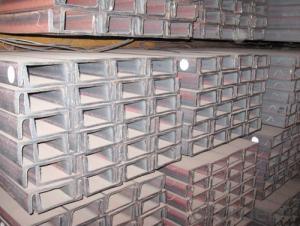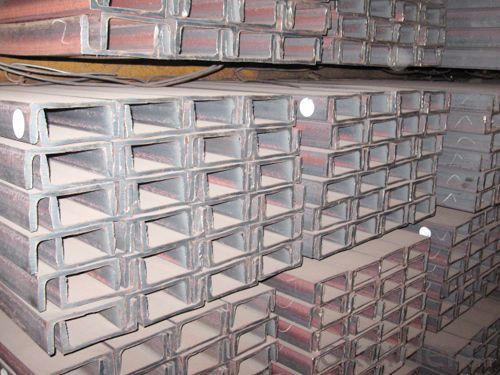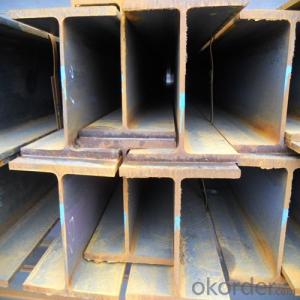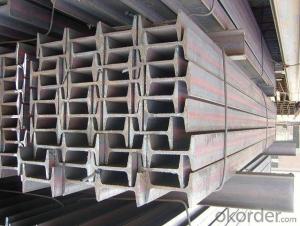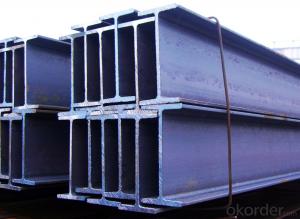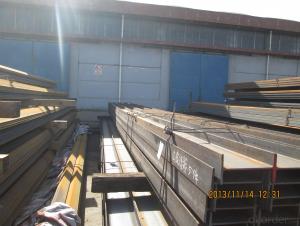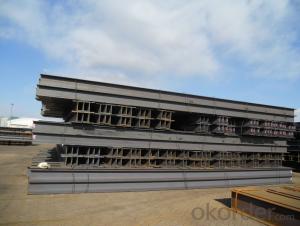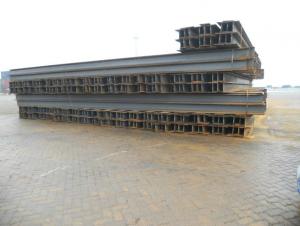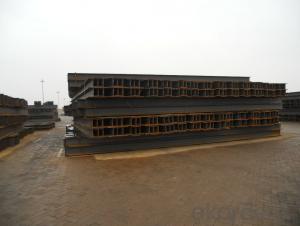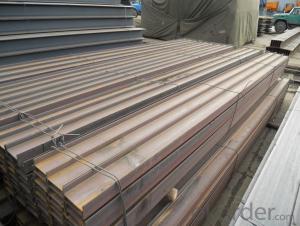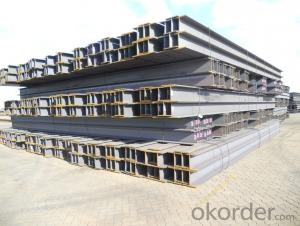H section steel / h steel column / h steel pile
- Loading Port:
- China Main Port
- Payment Terms:
- TT OR LC
- Min Order Qty:
- -
- Supply Capability:
- -
OKorder Service Pledge
OKorder Financial Service
You Might Also Like
Specifications
1. HIGH QUALITY & LOW PRICE
2. DIFFERENT CERTIFICATIONS FOR DIFFERENT COUNTRY
3. SATISFY DIFFERENT REQUIREMENTS
Grade: Q235B, Q235, Q345B, SS400, A36…
Standard: JIS/ ASTM/ GB/ BS/ ...
Length: 5.8m, 6m, 12m, or as the customers’ requirements.
Usage:
(1).used for the plant, high-rise building construction
(2).used for the bridge, shipment building
(3).used for lifting and transportation machinery, equipment manufacturing base building
(4).used for the support, foundation pile manufacturing
5. Payment terms: 30% tt in advance, the balance against the LC or the copy of BL.
| SPECIFICATION | WEIGHT KG/M | |
| 100*100*6*8 | TON | 16.90 |
| 125*125*6.5*9 | TON | 23.60 |
| 150*150*7*10 | TON | 31.10 |
| 175*175*7.5*11 | TON | 40.40 |
| 200*200*8*12 | TON | 49.90 |
| 200*204*12*12 | TON | 56.20 |
| 244*252*11*11 | TON | 63.80 |
| 250*250*9*14 | TON | 71.80 |
| 250*255*14*14 | TON | 81.60 |
| 294*302*12*12 | TON | 83.50 |
| 300*300*10*15 | TON | 93.00 |
| 300*305*15*15 | TON | 104.80 |
| 338*351*13*13 | TON | 104.60 |
| 344*348*10*16 | TON | 113.00 |
| 344*354*16*16 | TON | 129.30 |
| 350*350*12*19 | TON | 134.90 |
| 350*357*19*19 | TON | 154.20 |
| 388*402*15*15 | TON | 140.10 |
| 394*398*11*18 | TON | 146.60 |
| 394*405*18*18 | TON | 168.30 |
| 400*400*13*21 | TON | 171.70 |
| 400*408*21*21 | TON | 196.80 |
| 414*405*18*28 | TON | 231.90 |
| 428*407*20*35 | TON | 283.10 |
| 458*417*30*50 | TON | 414.90 |
| 498*432*45*70 | TON | 604.50 |
| 492*465*15*20 | TON | 202.50 |
| 502*465*15*25 | TON | 239.00 |
| 502*470*20*25 | TON | 258.70 |
| 148*100*6*9 | TON | 20.70 |
| 194*150*6*9 | TON | 29.90 |
| 244*175*7*11 | TON | 43.60 |
| 294*200*8*12 | TON | 55.80 |
| 340*250*9*14 | TON | 78.10 |
- Q: How do steel H-beams contribute to water conservation in buildings?
- Steel H-beams contribute to water conservation in buildings by reducing the need for excessive water usage during construction. These beams are lightweight yet strong, allowing for the construction of sustainable and efficient structures. As a result, less water is required for construction purposes, leading to overall water conservation in buildings.
- Q: What are the different grades of Steel H-Beams available?
- There are several different grades of Steel H-Beams available in the market. The most commonly used grades include A36, A572, and A992. A36 is a low carbon steel that is widely used for general structural purposes. It has a yield strength of 36,000 psi and a tensile strength of 58,000-80,000 psi. A36 H-Beams are typically used in construction projects, bridges, and machinery. A572 is a high-strength, low-alloy steel that offers better strength and hardness than A36. It has a yield strength of 42,000-65,000 psi and a tensile strength of 60,000-80,000 psi. A572 H-Beams are commonly used in heavy construction, infrastructure development, and building projects that require high strength. A992 is a structural steel grade that is widely used for its superior mechanical properties. It has a yield strength of 50,000-65,000 psi and a tensile strength of 65,000-85,000 psi. A992 H-Beams are often used in high-rise buildings, bridges, and other demanding applications where superior strength and stability are required. Other less commonly used grades of Steel H-Beams include A588, A514, and A709. These grades offer specific properties and characteristics that make them suitable for certain applications. It is important to consult with a steel supplier or engineer to determine the most appropriate grade of Steel H-Beams for a specific project or application.
- Q: Are steel H-beams suitable for structures with high snow loads?
- Yes, steel H-beams are suitable for structures with high snow loads. Steel H-beams have excellent strength and load-bearing capacity, making them ideal for withstanding heavy snow loads. The H shape of the beam allows for efficient distribution of the load, providing stability and structural integrity. Additionally, steel is a durable and long-lasting material that can withstand harsh weather conditions, including heavy snow. Therefore, steel H-beams are commonly used in construction projects located in areas with high snow loads to ensure the safety and stability of the structure.
- Q: Can steel H-beams be used in warehouse or distribution center construction?
- Yes, steel H-beams can be used in warehouse or distribution center construction. Steel H-beams are typically used as structural supports and provide strength and stability to the building structure. They are commonly used in industrial and commercial construction projects due to their durability and load-bearing capabilities.
- Q: Why is it that the steel pile is low in cost and easy to construct, and it can be changed when there is an obstacle
- The H steel has wide flange, large lateral rigidity and strong bending resistance. It is about 5 to 10% of that of I-beam, and the flange two surfaces are parallel to each other, so the structure is convenient.
- Q: How are steel H-beams transported to construction sites?
- The transportation of steel H-beams to construction sites varies depending on their size, weight, and distance. One way to transport them is by using flatbed trucks or trailers equipped with cranes or forklifts. These trucks load and secure the H-beams with chains or straps to ensure safety during transportation. Another option, particularly for large-scale construction projects with significant distances, is to transport the H-beams by barges or ships if the construction site is near a waterway. Cranes are used to load the H-beams onto the watercraft, which then transports them to the site via water. For shorter distances, smaller H-beams can be transported using specialized trucks with cranes or forklifts. These trucks are designed to easily navigate roads and can load and unload the H-beams at the construction site. In cases where the construction site is inaccessible by road or water, helicopters or airplanes may be employed to transport the H-beams. This method is typically used for remote or hard-to-reach sites where traditional transportation options are not feasible. All in all, the transportation of steel H-beams to construction sites requires meticulous planning, coordination, and the utilization of specialized equipment to ensure a safe and efficient delivery.
- Q: How do you calculate the maximum shear stress in steel H-beams?
- To calculate the maximum shear stress in steel H-beams, you need to determine the shear force acting on the beam and divide it by the shear area. The shear force can be calculated by considering the applied loads and their distribution along the beam. The shear area can be determined by considering the geometry of the H-beam cross-section.
- Q: What are the different types of steel H-beam connections used in industrial facilities?
- Industrial facilities commonly use several different types of steel H-beam connections to provide structural stability and support in large-scale construction projects. The following are some frequently used types: 1. The most commonly used type is welded connections. These involve welding the H-beams together at the joint, creating a strong and rigid connection. Welded connections are known for their high strength and durability, making them suitable for heavy-duty applications. 2. Bolted connections involve securing the H-beams together using bolts and nuts. They can be easily disassembled and reassembled, making them ideal for situations where flexibility and future modifications are required. However, they may not be as strong as welded connections. 3. Riveted connections are an older method that uses metal rivets to join the beams together. They have been largely replaced by welded and bolted connections due to their higher cost and time-consuming installation process. However, they are still used in some historical or heritage structures. 4. Moment connections, also known as rigid connections, are designed to resist bending moments and provide greater stability. Additional plates are welded or bolted to the beam ends, creating a stiffer connection that can resist rotational forces. 5. Pinned connections allow for rotation between the beams, providing flexibility in the structure. They are commonly used in structures where movement or deflection is expected, such as bridges or earthquake-resistant buildings. Pinned connections can be achieved through the use of specialized pins or bearings. 6. Shear connections transfer shear forces between the beams. They are typically made through the use of bolts or welding additional plates to the beam ends. Shear connections are crucial for ensuring the structural integrity of the H-beam system during lateral loads or vibrations. It is important to consider factors such as load-bearing requirements, structural design, project specifications, and cost when selecting the appropriate H-beam connection type. Consulting with a structural engineer or construction professional is recommended to determine the most suitable connection type for a specific industrial facility.
- Q: How do steel H-beams contribute to indoor air quality in buildings?
- Steel H-beams play a minimally direct role in contributing to indoor air quality in buildings. As load-bearing structural elements, H-beams are typically made from steel, which is an inert material that does not release any volatile organic compounds (VOCs) or harmful emissions. Unlike certain building materials such as wood or certain types of plastics, steel H-beams do not emit any pollutants or allergens into the indoor air. However, it is important to note that the overall indoor air quality of a building is influenced by a wide range of factors, including ventilation systems, building materials, furniture, and occupant activities. Steel H-beams indirectly contribute to a healthy indoor environment by providing a sturdy and durable framework for the building, allowing for proper ventilation and effective air circulation. Furthermore, steel H-beams are commonly used in construction projects due to their fire-resistant properties. In the event of a fire, steel does not release toxic gases or smoke that can compromise indoor air quality. This enhances the safety of the building occupants and minimizes the potential health risks associated with poor air quality during fire incidents. In conclusion, while steel H-beams themselves do not directly impact indoor air quality, they contribute to a healthier indoor environment through their non-emissive nature and fire-resistant properties. The overall indoor air quality is influenced by a combination of factors, and the use of steel H-beams helps create a safe and sustainable building structure that supports good air quality.
- Q: Are there any limitations or restrictions on the use of steel H-beams?
- Yes, there are certain limitations and restrictions on the use of steel H-beams. These restrictions primarily depend on the specific application and building codes/regulations in place. Factors such as load-bearing capacity, span length, column spacing, and fire resistance may impose limitations on the use of steel H-beams. Additionally, local authorities or engineering standards may dictate certain requirements, such as welding specifications or the need for additional support structures. It is crucial to consult with a qualified structural engineer or refer to relevant building codes to ensure compliance and safe use of steel H-beams.
Send your message to us
H section steel / h steel column / h steel pile
- Loading Port:
- China Main Port
- Payment Terms:
- TT OR LC
- Min Order Qty:
- -
- Supply Capability:
- -
OKorder Service Pledge
OKorder Financial Service
Similar products
Hot products
Hot Searches
Related keywords
